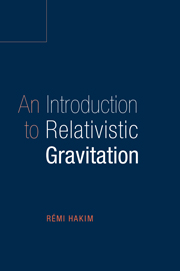Book contents
- Frontmatter
- Contents
- Preface
- 1 NEWTONIAN GRAVITATION
- 2 MINKOWSKI SPACE–TIME
- 3 THE RELATIVISTIC FORM OF PHYSICAL LAWS
- 4 GRAVITATION AND SPECIAL RELATIVITY
- 5 ELECTROMAGNETISM AND RELATIVISTIC HYDRODYNAMICS
- 6 WHAT IS CURVED SPACE?
- 7 THE PRINCIPLE OF EQUIVALENCE
- 8 EINSTEIN'S RELATIVISTIC GRAVITATION (GENERAL RELATIVITY)
- Appendix A Tensors
- Appendix B Exterior Differential Forms
- Appendix C Variational Form of the Field Equations
- Appendix D The Concept of a Manifold
- References
- Physical Constants
6 - WHAT IS CURVED SPACE?
Published online by Cambridge University Press: 05 June 2012
- Frontmatter
- Contents
- Preface
- 1 NEWTONIAN GRAVITATION
- 2 MINKOWSKI SPACE–TIME
- 3 THE RELATIVISTIC FORM OF PHYSICAL LAWS
- 4 GRAVITATION AND SPECIAL RELATIVITY
- 5 ELECTROMAGNETISM AND RELATIVISTIC HYDRODYNAMICS
- 6 WHAT IS CURVED SPACE?
- 7 THE PRINCIPLE OF EQUIVALENCE
- 8 EINSTEIN'S RELATIVISTIC GRAVITATION (GENERAL RELATIVITY)
- Appendix A Tensors
- Appendix B Exterior Differential Forms
- Appendix C Variational Form of the Field Equations
- Appendix D The Concept of a Manifold
- References
- Physical Constants
Summary
We shall see at the end of this chapter that relativistic gravitation will require the introduction of curved space–time. We should ask what “curved space” actually is. Our intuition, based on surfaces in R3, can be extended to spaces of dimension larger than two. We can deduce the essentials from simple examples [like the sphere] of surfaces in R3. We shall do this, first by studying some geometric properties of known surfaces, and then comparing them with corresponding properties of the plane R2. We then define the Riemann curvature and finally give arguments leading to curved space–time.
Some manifestations of curvature
Here we consider only a sphere of radius R embedded in R3: clearly this is a curved surface. We shall try to construct elementary geometrical figures whose properties we compare with the analogous plane figure.
(1) Geodesic triangle (Fig. 6.1): In the plane, a triangle is formed by the intersection of three non-parallel straight lines. On a sphere, arcs of great circles play the role of straight lines: a straight line in the plane R2, is the shortest path (geodesic) between two points, while for the sphere S2 the geodesies are arcs of great circles. We thus can construct a triangle on the sphere S2; between two points A and B there is an arc of a great circle (exactly one, if the distance AB is to be a minimum and A, B are not at poles).
- Type
- Chapter
- Information
- An Introduction to Relativistic Gravitation , pp. 116 - 138Publisher: Cambridge University PressPrint publication year: 1999



